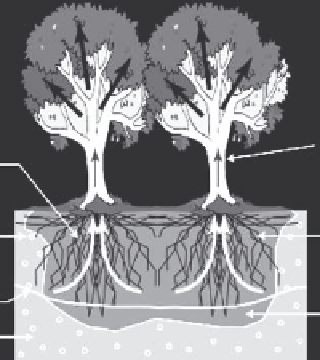Environmental Engineering Reference
In-Depth Information
Tree roots take
in water and
pollution from
the ground
Water enters tree
where pollution is
cleaned up
Polluted soil
Clean soil
Water table
Polluted
groundwater
Clean
groundwater
FIGURE 11.7
Example of phytoremediation. (From United States Environmental Protection Agency (USEPA),
Phytoremediation
Resource Guide
, EPA 542-B-99-003, Office of Solid Waste and Emergency Response, Washington, DC, 1999a.)
mechanical migration of contaminants. Vegetation can also reduce the amount of water
migrating through the contaminant zone in the soil, thus decreasing the leaching or dis-
solving of contaminants into deeper soil and eventually to groundwater (Figure 11.7). The
use of phytoremediation techniques has been limited by the uncertainty regarding the
collection and disposal of the resulting contaminated vegetative material at the end of
each growing season.
11.3.9 Soil Washing
Soil washing essentially “scrubs” soil to remove and separate the contaminant from soil
particles using detergents or other chemicals depending on the type of contaminant,
concentration, and soil type. Contaminants sorbed to soil particles can be removed or
separated by a detergent or chemical used to lower the sorptive potential of the contami-
nants. Some heavy metals, fuels, and pesticides can be remediated using this technique
(Figure 11.8).
11.3.10 In Situ Thermal Treatment
In situ thermal treatment involves injecting a form of heat into subsurface soils to mobilize
the contaminants for easier recovery. Common heat sources include
• Steam
• Hot air
• Hot water
• Electrical resistance
• Radio frequency
• Thermal conduction

Search WWH ::

Custom Search